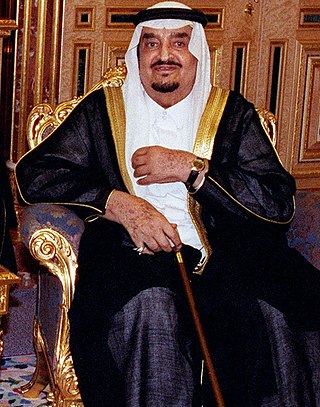
Fahd bin Abdulaziz Al Saud was King and Prime Minister of Saudi Arabia from 13 June 1982 until his death in 2005. Prior to his ascension, he was Crown Prince of Saudi Arabia from 1975 to 1982. He was the eighth son of King Abdulaziz, the founder of modern Saudi Arabia.

The House of Saud is the ruling royal family of Saudi Arabia. It is composed of the descendants of Muhammad bin Saud, founder of the Emirate of Diriyah, known as the First Saudi state (1727–1818), and his brothers, though the ruling faction of the family is primarily led by the descendants of Abdulaziz bin Abdul Rahman, the modern founder of Saudi Arabia. It forms a subtribe of the larger prominent ancient Banu Hanifa tribe of Arabia, from which well known 7th century Arabian theologist Maslama ibn Ḥabīb originates. The most influential position of the royal family is the King of Saudi Arabia, an absolute monarch. The family in total is estimated to comprise 15,000 members; however, the majority of power, influence and wealth is possessed by a group of about 2,000 of them. Some estimates of the royal family's wealth measure their net worth at $1.4 trillion.This figure includes the market capitalization of Saudi Aramco, the state oil and gas company, and its vast assets in fossil fuel reserves, making them the wealthiest family in the world and the wealthiest in recorded history.

Sultan bin Abdulaziz Al Saud, called Sultan the Good in Saudi Arabia, was the Saudi defense minister from 1963 to 2011 and the Crown Prince of Saudi Arabia from 2005 to 2011.

Nayef bin Abdulaziz Al Saud was the crown prince of Saudi Arabia and deputy prime minister from October 2011 and the minister of interior from October 1975 until his death in June 2012.

The Sudairi Seven, also spelled Sudairy or Sudayri, is the commonly used name for a powerful alliance of seven full brothers within the Saudi royal family. They are also sometimes referred to as the Sudairi clan or the Sudairi faction. They are among the forty-five sons of the country's founder, King Abdulaziz. The King had more sons with their mother, Hussa bint Ahmed Al Sudairi, than he did with any of his other wives.

Ahmed bin Abdulaziz Al Saud is a member of House of Saud who served as deputy minister of interior from 1975 to 2012 and briefly as minister of interior in 2012. He was detained in March 2020 on the orders of his brother and nephew, King Salman and Crown Prince Mohammed bin Salman, respectively, and charged with treason.

Salman bin Abdulaziz Al Saud is King of Saudi Arabia, reigning since 2015, and was also Prime Minister of Saudi Arabia from 2015 to 2022. The 25th son of King Abdulaziz, the founder of Saudi Arabia, he assumed the throne on 23 January 2015. Prior to his accession, he was Crown Prince of Saudi Arabia from 18 June 2012 to 23 January 2015. Salman is the third oldest living head of state, the oldest living monarch, and Saudi Arabia's first head of state born after the unification of Saudi Arabia. He has a reported personal wealth of at least $18 billion, which makes him the third wealthiest royal in the world and one of the wealthiest individuals in the world.

Muhammad bin Abdulaziz Al Saud was the crown prince of Saudi Arabia from 1964 to 1965 and the nominal governor of Al Madinah Province from 1925 to 1954. He resigned as crown prince in order to pave the way for his brother Khalid bin Abdulaziz to become the heir apparent. Prince Muhammad was one of the wealthiest and most powerful members of the House of Saud. His advice was sought and deferred to in all matters by his brothers.

Sa'ad bin Abdul Rahman Al Saud (1890–1915) was the brother of Abdulaziz, Emir of Nejd. He was one of Abdulaziz's most devoted supporters and a key lieutenant in his early military campaigns.
Abdullah bin Abdul Rahman Al Saud was a Saudi Arabian statesman, soldier, and royal counsellor. He was a prominent advisor and member of the inner council of his elder half-brother, King Abdulaziz. After Abdulaziz died in 1953, Prince Abdullah continued to be involved in state affairs during the reigns of his nephews Saud, Faisal, and Khalid. He died in 1976.

Muhammad bin Abdul Rahman Al Saud was an Arabian soldier and politician who played a role in the conquests of his half-brother Abdulaziz that led to the formation of the Kingdom of Saudi Arabia.

Muqrin bin Abdulaziz Al Saud is a Saudi Arabian politician, businessman, and former military aviator who was briefly Crown Prince of Saudi Arabia from January to April 2015, during the first three months of his half-brother King Salman's reign. He is the 35th son of King Abdulaziz, born to Abdulaziz's Yemeni concubine Baraka. Since the death of Abdulaziz's 36th son Hamoud in 1994, Muqrin has been the youngest surviving son of the king.

The Prime Minister of Saudi Arabia is the chairman of the Council of Ministers and head of government of the Kingdom of Saudi Arabia. The Prime Minister is always either the King of Saudi Arabia or Crown Prince of Saudi Arabia. Prince Mohammed bin Salman has been Prime Minister since 27 September 2022.
Hussa bint Ahmed Al Sudairi was one of the wives of King Abdulaziz of Saudi Arabia, with whom she had seven sons and four daughters. Her sons included two future Saudi kings, Fahd and Salman, as well as Sultan bin Abdulaziz and Nayef bin Abdulaziz, who both later served as crown prince. Her sons with Abdulaziz are commonly known as the Sudairi Seven.

Muhammad bin Nayef Al Saud, colloquially known by his initials MBN or MbN, is a former Saudi Arabian politician and businessman who served as the crown prince and first deputy prime minister of Saudi Arabia from 2015 to 2017 and as the minister of interior from 2012 to 2017. Prince Muhammad is a grandson of the founding monarch, King Abdulaziz, and son of the former crown prince Nayef bin Abdulaziz. Muhammad and Nayef were the first father-son duo in Saudi history to serve as crown prince. Muhammad's uncle King Salman named him as crown prince on 29 April 2015. On 21 June 2017 the king appointed his own son, Mohammed bin Salman, as crown prince and relieved Muhammad bin Nayef of all positions. He has been in detention since 6 March 2020 along with his uncle Ahmed and his half-brother Nawwaf.

The Allegiance Council, also known as the Allegiance Commission or Allegiance Institution or Succession Commission, is the body responsible for determining future succession to the throne of Saudi Arabia. It was formed on 7 December 2007 by King Abdullah. At the time of its formation, the Council's intended function was to appoint a Crown Prince once a new King succeeds to the throne.
Saud bin Nayef Al Saud is a Saudi Arabian politician who has served as governor of Eastern Province since 2013. A member of the House of Saud, he is the former head of the Crown Prince Court and special advisor to the Saudi Crown Prince. Prince Saud was once regarded as one of the candidates for king or crown prince when succession passed to the new generation. However, on the death of King Abdullah in 2015, he was passed over in the line of succession in favor of his younger brother Mohammed bin Nayef. Prince Saud has been the governor of the Eastern Province since 13 January 2013.

The King of Saudi Arabia, officially the King of the Kingdom of Saudi Arabia, is the monarch and head of state/government of the Kingdom of Saudi Arabia who holds absolute power. He is the head of the Saudi Arabian royal family, the House of Saud. The king is the supreme commander-in-chief of the Royal Saudi Armed Forces and the head of the Saudi national honors system. The king is called the "Custodian of the Two Holy Mosques", a title that signifies Saudi Arabia's jurisdiction over the mosques of Masjid al-Haram in Mecca and Al-Masjid an-Nabawi in Medina. The title has been used many times through the history of Islam. The first Saudi king to use the title was Faisal; however, King Khalid did not use the title after him. In 1986, King Fahd replaced "His Majesty" with the title of Custodian of the Two Holy Mosques, and it has been since used by both King Abdullah and King Salman. The king has been named the most powerful and influential Muslim and Arab leader in the world according to the Muslim 500.

The crown prince of Saudi Arabia is the second-most important position in Saudi Arabia, second to the King, and is his designated successor. Currently, the Crown Prince assumes power with the approval of the Allegiance Council after he is nominated by the King. This system was introduced to the country during the reign of King Abdullah. In the absence of the King, an order is issued to have the Crown Prince manage the affairs of the state until the King's return.

Abdulaziz bin Abdul Rahman Al Saud (1875–1953), the founder and first king of Saudi Arabia, also called Ibn Saud, was very young when he first got married. However, his wife died shortly after their marriage. Ibn Saud remarried at eighteen and his firstborn child was Prince Turki I. He had 45 sons of whom 36 survived to adulthood and had children of their own. He also had many daughters. He is thought to have had 22 wives.
















